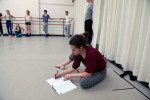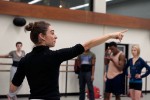Title
It’s not every choreographer who would take up the challenge presented by Lawrence Rhodes, artistic director of Juilliard’s Dance Division, when he invites someone to participate in the annual New Dances program. In many situations, a choreographer beginning a new work makes the decisions about which dancers—and how many—will be in the cast. But for this unusual and inventive project, now in its ninth year, four choreographers are invited to work with an entire Dance Division class. This year, that means keeping anywhere from 19 to 26 bodies in motion. It may not be for everyone, but this year’s choreographers—whether or not they had much experience with such large ensembles—embraced it as a welcome opportunity.
Body
“It’s a unique aspect of the project, because I want to make everybody feel very fulfilled and utilized within the work,” Alex Ketley, who is choreographing for the second-year students, recently told The Journal. He admits that taking on such a large group “is not where my heart naturally points;” the works he creates for his San Francisco company, the Foundry, are usually for 10 or fewer performers. “The challenge of this is: How do you utilize 26 dancers, who are all amazing? Currently in my process I’m building up these large fields of dance, where everybody’s doing everything—which I’m going to tear back down. I’m going to start, in a reductionist sense—drawing people out, and having them do different things, and drawing them back a bit.”
Alexander Ekman, on the other hand, is in his element. “I usually make big group pieces; I think it’s one of my strengths,” said the Swedish choreographer while working with the fourth-year class. (An upcoming work of his for the Royal Swedish Ballet will have a cast of 60.) At Juilliard, he warmed up for his assignment by creating the invigorating final bow for last year’s Senior Showcase. For New Dances, he notes, “I want them all to dance at the same time, because they’re students, and it’s not really like a company. Here it’s a bit more about the process, which is a nice change.”
Pam Tanowitz, the New York City-based choreographer who is working with the third-year students, is known for the intimate, detailed, musically sensitive work she creates for her own ensemble, Pam Tanowitz Dance. She did get to work on a grander scale when she choreographed a work to Schubert’s Wanderer Fantasy for 18 SUNY Purchase students. She is drawing on that, and on her own student experiences, as she creates Fortune, set to Charles Wuorinen’s composition of the same name, for her cast of 22. Tanowitz is the only one of the New Dances choreographers using an existing score; the other three are compiling collages for mixed sources. “I’ve worked with Wuorinen’s music before, and feel I connect to it,” she said in an interview with The Journal. I wanted to use live music, since I’m at Juilliard! This piece is intellectual in the way it’s put together, but I was also responding to something visceral underneath.”
Monica Bill Barnes, who has had a particularly busy and visible year on the local dance scene, welcomed the chance to work on a more expansive scale as part of Juilliard New Dances because she mostly creates for Monica Bill Barnes & Company, which is quite small. “It’s a pleasure to work with a lot of bodies—but 26 is more than I’m used to,” she said about the first-year class. She has worked with sizable student casts at several universities, but finds the Juilliard situation is unique because Rhodes gives the students “a really generous amount of time, which I think is so wise on his end, because I feel that with less time, you end up taking less risk, and you end up making probably fine work, but [work that] doesn’t give students a real sense of process,” she said.
An Innate Curiosity About Movement
The quartet of choreographers has been working in neighboring third-floor studios at Juilliard since mid-October. A youthful group representing a wide variety of backgrounds, they share an openness and defiance of categorization typical of today’s dance world, in which multiple influences and a willingness to break boundaries make it difficult, and often irrelevant, to apply labels. During interviews with The Journal in early November—very much mid-process—it became evident that these four also share an innate curiosity about movement that led them to shift their focus from performing to choreographing, however diverse the paths they followed to make that transition.
When Ketley last spent time at Lincoln Center, he was a student at the School of American Ballet, where he was in the cast of Jerome Robbins’ 2- and 3-part Inventions, created for the 1994 S.A.B. Workshop. He danced with San Francisco Ballet for four years before he and a colleague launched the Foundry, where he has been the sole director since 2003. His creations there include multimedia and video-based works, some incorporating text. This seemingly 180-degree shift in approach from S.A.B. can also be seen as reconnecting to earlier influences, since as a young boy Ketley attended classes and dance camps where postmodern dance figures were teaching; not many S.A.B. alumni would mention Yvonne Rainer, as he does.
At 14 his focus went to ballet, but despite entering a leading company, he soon ventured beyond performing. “During my time at S.A.B., I already was thinking that choreography was something I wanted to do. I really loved ballet while I was doing it, but I was much more excited by different contemporary choreographers, and I felt isolated in a big ballet company.” When he left the San Francisco Ballet to start the Foundry, he focused on “how the application of environment affects the generation of movement,” he said. “I started to generate movement from a really experiential place, as opposed to ‘how do things look in space.’”
Ekman—who moved to New York a year ago—also has ballet credentials; he performed with the Royal Swedish and Cullberg Ballets. But those are troupes with a strongly contemporary focus where tutus-and-tiaras repertory is rarely in the mix. He also performed with the decidedly nonclassical Nederlands Dans Theater, where he remains one of the resident choreographers. Unlike U.S. troupes, in Europe “most of these modern companies have workshops where the dancers can choreograph. I tried, and I loved it immediately. To hear reactions from the audience, and see your ideas become reality—it’s amazing.”
Ekman’s only previous New York showcase was a 2010 work, Hubbub, for Cedar Lake. “My work is often quite humorous. I never go into the studio trying to make something funny. That would be a disaster. It’s more that it just becomes funny—or entertaining. And I think there’s also something deeper and darker in my work, and people sometimes laugh for uncomfortable reasons.”
Tanowitz, a 2011 Guggenheim Fellow, went the academic route in dance, earning a B.F.A. from Ohio State University and an M.F.A. from Sarah Lawrence. She was drawn to choreography from her experiences at O.S.U. and the intensely creative atmosphere at the American Dance Festival. “I liked performing, but I realized my interests were elsewhere,” she said. “At school, I noticed that I was getting more attention in my comp classes than in my technique classes. It was like solving a puzzle.”
Barnes, a transplanted Californian, received her M.F.A. in dance from N.Y.U./Tisch School of the Arts, and has been creating works in New York since 1997. She continues to perform in them, but felt an early push towards choreography. “In a way, it really came from having instincts as a performer—trying to seek those out,” she recalled. “I had wonderful experiences dancing with many people, but I realized the sort of dances, and sort of situations, in which I wanted to perform didn’t exist. So I had to make them up.”







